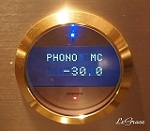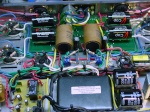+4
Pillo69
ArlanB
Bob Latino
LeGrace
8 posters
Bias checking frequency

LeGrace- Posts : 388
Join date : 2016-08-07
Location : Ontario, Canada
- Post n°1
 Bias checking frequency
Bias checking frequency
As recently shared in another thread just experienced another red plate, about 6 weeks following the first one. Turns out cause was bias dropping on one tube pair down to only 0.5v. Other tube pair still on target at 1v. So I adjusted the bias pot back up to 1v and all back to normal. I've been checking bias every 2-3 weeks which evidently is not often enough. After this I'm thinking should be checked at least every other day? Didn't appreciate it could drift that far in just 2-3 weeks.

Guest- Guest
- Post n°2
 Re: Bias checking frequency
Re: Bias checking frequency
I check every time I turn my amp on. Excessive? Probably, but it doesn't hurt.

Bob Latino- Admin
- Posts : 3262
Join date : 2008-11-26
Location : Massachusetts
- Post n°3
 Re: Bias checking frequency
Re: Bias checking frequency
As the tubes wear in a little, the bias will change slightly .. Every 3 weeks to a month is about right. If you want to check it more often, that is OK ... Other things like your line voltage at the time you check will cause slight changes to the bias. Also - When the amp is brand new and you set the bias when the amp is cold, you should set the bias a little lower than normal. As the amp warms up over the first half hour, the bias will rise slightly. Always make your final bias setting with the amp fully warmed up. Also remember that when the tubes are NEW the bias will change to a greater degree than when the amp has some time on it.
The one thing you should not try to do is to get the bias "perfect". If you target bias is 1.00 VDC per side on an M-125 amp using 4 output tubes, anything between .900 VDC and 1.10 VDC per side is close enough
Bob
The one thing you should not try to do is to get the bias "perfect". If you target bias is 1.00 VDC per side on an M-125 amp using 4 output tubes, anything between .900 VDC and 1.10 VDC per side is close enough
Bob

ArlanB- Posts : 73
Join date : 2011-01-23
Age : 76
Location : Santa Cruz, California
- Post n°4
 Re: Bias checking frequency
Re: Bias checking frequency
Excessive? I don't think so. After my power tube red plate session two months ago in my ST-120, I decided to keep a log of the AC line in and the bias at the end of my listening sessions. I found that the line voltage varied from 118.1 to 121.0 vac and the bias would rise or fall accordingly, but would remain within an acceptable range of +- .015 volts on each tube. Also I found that the bias would rise initially slightly beyond .520 on initial startup, and then would slowly fall over the listening session back to within the .515 - .495 range of .500 at the end of the session. So I have learned not to have "Jerkitis" as they say in photography and try not to be obsessive about the bias. I never did find out why the tube red plated. All I can attribute it to was tube failure due to age (almost 5 yrs. old on this set of KT88's). I did a circuit check of the bias system at the time and all is well. Changed out the whole set of power tubes with a new set and no further trouble. I have had my amp for 9 years and have never regretted a single moment of it.
Thank You Bob! My music never sounded so good.
Thank You Bob! My music never sounded so good.

LeGrace- Posts : 388
Join date : 2016-08-07
Location : Ontario, Canada
- Post n°5
 Re: Bias checking frequency
Re: Bias checking frequency
The more folks share their own red plate experiences the more I feel I'm not a freak, thanks Arlan! I'm now logging my bias readings daily to see if I can observe any trends. The red plate was inconsequential, in that once I adjusted the bias back to target the recalcitrant tube is back to normal. The question I struggle with, why did the bias shift so much?

ArlanB- Posts : 73
Join date : 2011-01-23
Age : 76
Location : Santa Cruz, California
- Post n°6
 Re: Bias checking frequency
Re: Bias checking frequency
Red plating is in my history. I have a Heathkit integrated amp that I constructed in the early 60's while I was in high school. It ran fine until about 13 years ago and it started red plating the power tubes (7591's). This happened 3 times over 4 years and I finally had to make a decision whether to repair or replace. I tried repairing it, however one problem led to a cascade of problems, it was over 40 years old and I had a craving for more power, Soooo! At that time was when Bob started advertising the VTA ST-120 on EBAY. So I made the choice to replace and I am so glad that I did. So red plating will grace us all at one time or another.

Pillo69- Posts : 176
Join date : 2012-04-11
Location : Granada (España)
- Post n°7
 Re: Bias checking frequency
Re: Bias checking frequency
Checking the bias of the tubes is a good option, even if the tubes have many hours of use.
I consider that the problem occurs by the tubes (use of them) rather than by bias problems.
Many tubes are offered on the web (taking advantage of the Boom for vintage), which in their 90% are in poor condition.
Checking the tubes after a time of use indicates the condition of the tubes. An Electro-Harmonic 6CA7 of my ST70 turned red (4-5 years of use). The result of the tube can be seen in the following images.
The same tube placed in a normal emissivity tester gives a good value.


I consider that the problem occurs by the tubes (use of them) rather than by bias problems.
Many tubes are offered on the web (taking advantage of the Boom for vintage), which in their 90% are in poor condition.
Checking the tubes after a time of use indicates the condition of the tubes. An Electro-Harmonic 6CA7 of my ST70 turned red (4-5 years of use). The result of the tube can be seen in the following images.
The same tube placed in a normal emissivity tester gives a good value.



deepee99- Posts : 2244
Join date : 2012-05-23
Location : Wallace, Idaho
- Post n°8
 Re: Bias checking frequency
Re: Bias checking frequency
Watching a power tube commit suicide is a glorious experience, especially if the room is dark at the time and you're trying to impress company. Starts with a little blue flame, then that spectacular red light show, and your neighbours' houses go dark as the power-pole transformer explodes.
If you haven't yet enjoyed such an event, you're either very lucky, or you're next.
I'm OCD about new or alleged NOS tube bias, taking into account line-voltage fluctuations, for the 100 hours or so -- after which it's the occasional monthly check as Bob L recommends.
I would add one suggestion to what Bob L thoroughly covered and that is: trust your ears. If the gain starts to drop or the sound starts to seem a bit flat on one of the channels, you've likely got a lame tube. Even a daily bias check will not always predict this.
If you haven't yet enjoyed such an event, you're either very lucky, or you're next.
I'm OCD about new or alleged NOS tube bias, taking into account line-voltage fluctuations, for the 100 hours or so -- after which it's the occasional monthly check as Bob L recommends.
I would add one suggestion to what Bob L thoroughly covered and that is: trust your ears. If the gain starts to drop or the sound starts to seem a bit flat on one of the channels, you've likely got a lame tube. Even a daily bias check will not always predict this.

audiobill- Posts : 425
Join date : 2014-03-13
Location : Albany, NY
- Post n°9
 Re: Bias checking frequency
Re: Bias checking frequency
A tube PAIR (two tubes in amp) should be biased at .5v. A tube SET (four tubes in amp) would be 1v, as you are setting yours to......

deepee99- Posts : 2244
Join date : 2012-05-23
Location : Wallace, Idaho
- Post n°10
 Re: Bias checking frequency
Re: Bias checking frequency
Depends on volts that get to the plates. Drop plate volts, raise bias and vice-versa.audiobill wrote:A tube PAIR (two tubes in amp) should be biased at .5v. A tube SET (four tubes in amp) would be 1v, as you are setting yours to......

audiobill- Posts : 425
Join date : 2014-03-13
Location : Albany, NY
- Post n°11
 Re: Bias checking frequency
Re: Bias checking frequency
David, true but I was responding only to the OP's question, not the broader point.
Cheers -
Cheers -

deepee99- Posts : 2244
Join date : 2012-05-23
Location : Wallace, Idaho
- Post n°12
 Re: Bias checking frequency
Re: Bias checking frequency
audiobill wrote:David, true but I was responding only to the OP's question, not the broader point.
Cheers -
Good morning, Brother Bill. Indeed, I wandered off course a bit, lacking both a magnetic and moral compass. . .
The OP's question centres on the ideal bias point for a pair of KT-88/KT-120 type tubes. In my first M-125s (not the much better ones you built for me a fews later) the destructions called for a bias of 1.2VDC per pair of tubes, i.e. 0.6/tube. A few years' experience in the field with the new-issue TS KT-120s and GL KT-88s emerged a consensus that 0.55/tube, or 1.1VDC for each pair, did not compromise sound quality and made life a little easier on the output tubes.
I've heard suggestions from the God of all Vintage Tubes, Andy Bowman, that with genuine NOS Tung-Sol 6550s should be run in at an even lower bias point, 0.45/tube, then slowly brought up to .5 or .55 but no higher.
This is probably "inside baseball" kinda stuff.
If I had one gripe about the VTA amp series it is that a single pot and test point taking the bias check off a pair of tubes can be confusing for a newbie because you're always just getting and setting a pair's average bias. Kinda like one foot in a bucket of ice-water and the other on a red-hot stove. This design makes good economic sense as each pair is working off the same bias circuit, and there's that big wire-wound resistor protecting each tube, and from an audio POV it's the sum of the behaviour or two tubes working in tandem. But the ability to check each tube's health would be a nice option.

arledgsc- Posts : 495
Join date : 2012-11-30
Age : 70
Location : Santa Rosa CA
- Post n°13
 Re: Bias checking frequency
Re: Bias checking frequency
I check bias on new power tube installs once a day until confident they hold steady. Then check about every two weeks.

deepee99- Posts : 2244
Join date : 2012-05-23
Location : Wallace, Idaho
- Post n°14
 Re: Bias checking frequency
Re: Bias checking frequency
ass-U-me - ing a constant supply voltage from the wall, output tubes will rise to their peak bias VDC at the ~ 2-hour mark from a cold start -- at least that's been my experience. If they're not above Bob L's limits by then, you should be good to go. Again, watch new tubes like a hawk for their first several dozen or even first 100 hours, after which, absent sonic anomalies or light shows, it's more like checking the oil and radiator levels in your car on a regular basis, but nothing to obsess over. If you want to get OCD about wall voltage, get a $20 watt-meter off Amazon, or better yet, ask your local power company's line-man when the load peaks and dips are on your particular grid (he'll know) on a typical day. When the demand is lowest, your wall voltage will be at its highest, as will your bias VDC.
Last edited by deepee99 on Tue Jul 18, 2017 1:34 pm; edited 1 time in total (Reason for editing : crappy diction)

LeGrace- Posts : 388
Join date : 2016-08-07
Location : Ontario, Canada
- Post n°15
 Re: Bias checking frequency
Re: Bias checking frequency
One of the possible side benefits of tube rectification is the canary in the coal mine analogy? In that when my bias drifted way off the tube visually let me know something was amiss. How would you know with a SS rectifier? Burning smell/smoke? 


deepee99- Posts : 2244
Join date : 2012-05-23
Location : Wallace, Idaho
- Post n°16
 Re: Bias checking frequency
Re: Bias checking frequency
LeGrace wrote:One of the possible side benefits of tube rectification is the canary in the coal mine analogy? In that when my bias drifted way off the tube visually let me know something was amiss. How would you know with a SS rectifier? Burning smell/smoke?
Well, LeGrace, being (next to me) the champion of Unexplained Thermal Events, look at it this way: If your chicken coop blows up, was it the propane or natural gas that did it? I don't think the roosters cared whether they were killed by s/s or a thermionic valve. . .
A $150 Mullard is, to continue the avian analogy, a pretty spendy canary. Unless a VTA builder/user knows better, I'd guess what whatever happened was probably above-ground, i.e. a lame tube, not some defect hidden by Bob or Roy below-decks. Those bias resistors are pretty tough.

tubed1- Posts : 29
Join date : 2012-01-03
- Post n°17
 Re: Bias checking frequency
Re: Bias checking frequency
A few words of wisdom from a very wise man, Jim McShane "tighten those socket pins after any indication of red plating" this tidbit of knowledge has saved me from some fairly expensive tech hours and put me back in the sweet spot for listening quickly. Please do some research before attempting this procedure as you can expose your self to high voltage for the uninitiated. After a serious flame out and pin re-tighten I now only bias 1x/ every couple of months at the most. Some tube manufacturers are just a tad out of tolerance and can cause pin socket stretch resulting in a no contact or weak tube pin contact and the dreaded flame diablo.

deepee99- Posts : 2244
Join date : 2012-05-23
Location : Wallace, Idaho
- Post n°18
 Re: Bias checking frequency
Re: Bias checking frequency
There is actually quite a wide variation in tube pin diameters. I pulled out my re-loading caliper and was quite surprised in the deviations even with the same brand and type of tube, and published the measurements somewhere on this board a few months ago. Too lazy to look it up but I think it was ~15 percent and some famed NOS tubes were the worst offenders.tubed1 wrote:A few words of wisdom from a very wise man, Jim McShane "tighten those socket pins after any indication of red plating" this tidbit of knowledge has saved me from some fairly expensive tech hours and put me back in the sweet spot for listening quickly. Please do some research before attempting this procedure as you can expose your self to high voltage for the uninitiated. After a serious flame out and pin re-tighten I now only bias 1x/ every couple of months at the most. Some tube manufacturers are just a tad out of tolerance and can cause pin socket stretch resulting in a no contact or weak tube pin contact and the dreaded flame diablo.
Obviously, putting a skinny pin into a socket hole that has been host to a fat pin almost guarantees trouble.
Re-tensioning the sockets every time you change octal or output tubes is mandatory, especially for tube-rollers. And there's no danger in doing it. Just turn off and un-plug the amp and wait until the tubes and chassis are cool to the touch. And pull the tubes as straight up as you can, grasping the glass and base together. Wiggling in excess puts a lot of stress on both tube and socket. This is not rocket science: a sturdy toothpick or tiny jeweler's flat screwdriver will do the trick.
|
|
|
